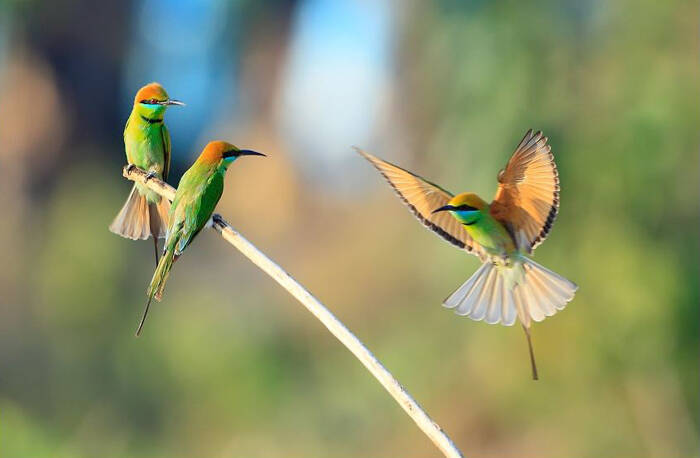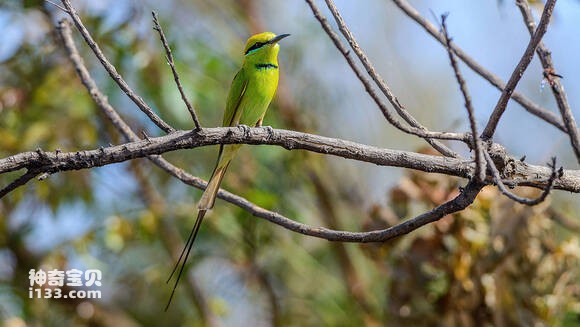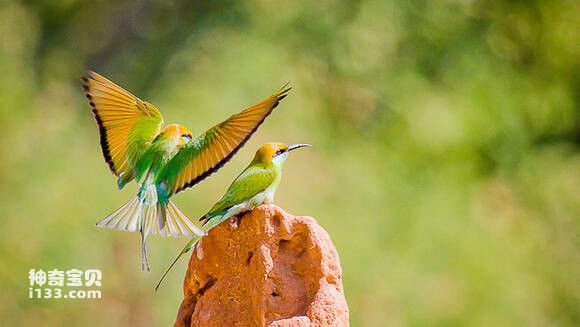Merops orientalis
IUCN
LCBasic Information
Scientific classification
- name:Merops orientalis
- Scientific Name:Merops orientalis,Green Bee-eater
- Outline:Climbing birds
- Family:order family genus
Vital signs
- length:18.5-24cm
- Weight:18-20g
- lifetime:No verification information
Feature
The throat is green, the forehead, top of the head and upper back are rusty red, and the rest of the upper body is bright green
Distribution and Habitat
Distributed in Bangladesh, Benin, Bhutan, Burkina Faso, Cambodia, Cameroon, Central African Republic, Chad, Cote d'Ivoire, Egypt, Eritrea, Ethiopia, Gambia, India, Islamic Republic of Iran, Iraq, Israel, Jordan, Laos People's Democratic Republic, Mali, Mauritania, Myanmar, Nepal, Niger, Nigeria, Oman, Pakistan, Palestine, Saudi Arabia, Senegal, South Sudan, Sri Lanka, Sudan, Thailand, Uganda, United Arab Emirates, Vietnam, Yemen, China (southwestern Yunnan , central and southern).
Traveling birds: Afghanistan, Bahrain, Greece, Libya.
It mainly inhabits open areas such as forest edges, bamboo forests, and savanna grass slopes. It also appears in urban parks and orchards, on the branches of bamboo forests on hillsides next to farmland, on bare branches in sparse forests, on power lines and even on the ground, and on farm cattle. on the back.
Appearance
The green-throated bee-eater is orange-brown from the top of the head to the back of the neck and on both sides, with a black eye pattern, and the eye pattern and chin are green-blue. The back to the upper tail coverts are fresh grass green, and the latter feather tips are blue; the tail feathers are dark grass green; the feather shafts are dark brown to black, and the narrow part of the central pair is completely black. The side tail feathers have a blue-green outer edge and a brown inner edge and feather tips; the wing surface is roughly the same color as the back, the tips of the tertiary flight feathers are blue, and the primary and secondary flight feathers have black feather tips. The throat and chest are orange-green, with a black semi-circular spot under the throat; the chest is light blue-green; the armpits, underwing coverts and leg coverts are light orange-brown.
The forehead to the back of the neck of the young bird is brown chestnut; the back and wings are dark green; t
Details
Green Bee-eater, also known as Green Bee-eater in English, is a small bird with 9 subspecies.

The green-throated bee-eater is a resident bird that moves in small groups. It is often seen perching on flying insects and suddenly rushing into the air to bite them. After catching the flying insects, it will fly around in an arc to a foothold and swallow them. Before swallowing, it is accustomed to hitting the prey (with the perching object) once. At sunset, they gather in large groups on lushly leafed trees or bamboo trees to spend the night. When they first arrive at the overnight site, they are very noisy. At one point, the whole group will explode and fly around in a panic, and finally gradually quiet down and stop. The next morning, often when the sun has risen, small groups can still be seen perching on trees in groups, facing the same direction, with their heads still under their wings and sleeping. They fly quickly, and their method is: they flap their wings quickly for a while and then glide for a while like a swallow. The call is pleasant and metallic, like the repetition of "tri-tri-tri", which is often made when flying.

The green-throated bee-eater mainly feeds on insects, especially flying insects such as Hymenoptera, including hymenoptera, dragonflies, small beetles and other insects; also includes bees, wasps, cicadas, moths, butterflies, termites, etc. Occasionally, locusts, grasshoppers, etc. are also eaten.

The breeding season of the green-throated bee-eater is about April to July every year. It usually nests on the rock slopes beside the forest edge road or on the cliffs on the river valley bank, digging holes for nests. It digs horizontal tunnels with a diameter of about 30-40 mm and a depth of about 0.5-2 meters on the sandy walls of the forest edge hillside gullies or roadsides. After years of use, it is common to see multiple nest holes scattered on one wall. The egg chamber is usually free of bedding, and some are just leftover insect debris such as wings and shells. Each nest lays 4-7 eggs, which are white and oval or round in shape. The male and female birds take turns to build nests, incubate eggs and raise chicks. The chicks are late-maturing.

Listed in the 2013 Red List of Endangered Species of the World Conservation Union (IUCN) ver 3.1 - Least Concern (LC).
Listed in the second level of the List of National Key Protected Wildlife in China.
Protect wild animals and stop eating game.
Maintaining ecological balance is everyone's responsibility!








